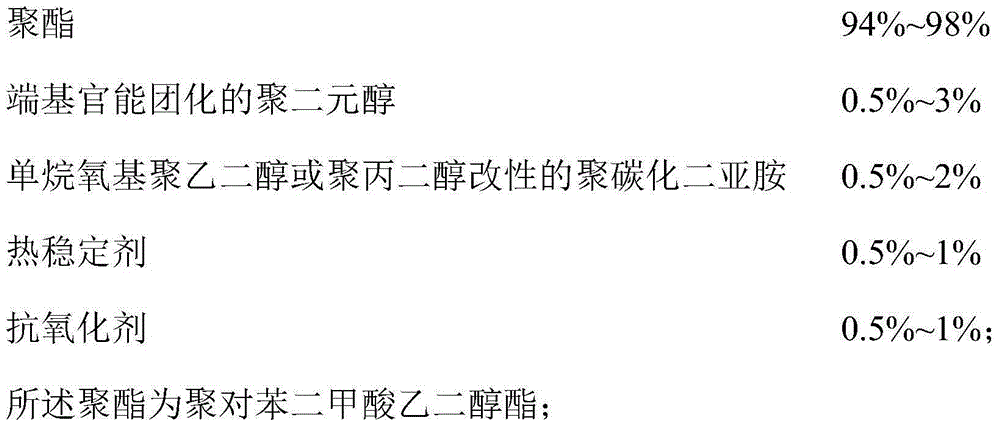A kind of anti-aging polyester modified material
A polyester modification and anti-aging technology, applied in the field of polyester modified materials, can solve the problems of harmful irritating odor of human body, increase of product yellowness index, poor thermal stability, etc., and achieve other ideal properties, elongation at break, etc. The effect of high retention rate and excellent hydrolysis resistance
- Summary
- Abstract
- Description
- Claims
- Application Information
AI Technical Summary
Problems solved by technology
Method used
Image
Examples
Embodiment 1~5
[0036] The components of the modified polyester in this example are as follows: PET resin (after vacuum drying at 150°C), and diaminopolyethylene glycol (H 2 N-PEG-NH 2 , purchased by Xiamen Sinobanger Biotechnology Co., Ltd.), monomethoxypolyethylene glycol-capped poly4,4'-diphenylmethanecarbodiimide (expressed as MPEG-PMCDI), 0.5% triphosphate Methyl ester and 0.5% antioxidant 1010 were added into the mixer and mixed evenly, and then passed through the twin-screw extruder to make a 250 μm biaxially stretched film through the above-mentioned preparation process, and its carboxyl terminal concentration, yellowness index and aging resistance were tested. (The PET resin used in this example has an intrinsic viscosity of 0.67dl / g, a concentration of terminal carboxyl groups of 25eq / t, and a molecular weight of 18000-23000). When a large amount of diaminopolyethylene glycol is used, the melt viscosity is likely to increase due to the effect of the difunctional group, which brings...
Embodiment 6~8
[0044] The components of the modified polyester in this example are as follows: PET resin (after vacuum drying at 150°C), and amino polyethylene glycol monomethyl ether (MPEG-NH 2 , purchased by Xiamen Sinobanger Biotechnology Co., Ltd.), monomethoxypolyethylene glycol-capped poly4,4'-diphenylmethanecarbodiimide (expressed as MPEG-PMCDI), 0.5% triphosphate Methyl ester and 0.5% antioxidant 1010 (purchased by BASF) were added into the mixer and mixed evenly, and then passed through a twin-screw extruder to make a 250 μm biaxially stretched film, and its carboxyl terminal concentration, yellowness index and aging resistance were tested. Performance (the PET resin used in this example has an intrinsic viscosity of 0.67dl / g, a concentration of terminal carboxyl groups of 25eq / t, and a molecular weight of 18000-23000). Using amino polyethylene glycol monomethyl ether (MPEG-NH 2 ) modifier, due to the effect of a single functional group, the amount of addition should be increased, ...
Embodiment 9~12
[0052] The components of the modified polyester in this example are as follows: PET resin (after vacuum drying at 150°C), and diglycidyl polyethylene glycol (EO-PEG-EO, Xiamen Sinobanger Biotechnology Co., Ltd. purchased), monomethoxypolyethylene glycol-blocked polyisophorone carbodiimide (expressed as MPEG-PIPDI), 0.5% trimethyl phosphate and 0.5% antioxidant 1010 (purchased from BASF) were added After mixing by the mixer, a 250 μm biaxially stretched film was made through a twin-screw extruder, and its terminal carboxyl group concentration, yellowness index and aging resistance were tested (the intrinsic viscosity of the PET resin used in this example was 0.67dl / g, the concentration of terminal carboxyl groups is 25eq / t, and the molecular weight is 18000-23000). Processability, hydrolysis resistance The performance is relatively good, and the yellowness index is slightly higher, but when the added amount is too high, the processing performance becomes poor, and the results...
PUM
| Property | Measurement | Unit |
|---|---|---|
| melting point | aaaaa | aaaaa |
| thickness | aaaaa | aaaaa |
Abstract
Description
Claims
Application Information
 Login to View More
Login to View More - R&D
- Intellectual Property
- Life Sciences
- Materials
- Tech Scout
- Unparalleled Data Quality
- Higher Quality Content
- 60% Fewer Hallucinations
Browse by: Latest US Patents, China's latest patents, Technical Efficacy Thesaurus, Application Domain, Technology Topic, Popular Technical Reports.
© 2025 PatSnap. All rights reserved.Legal|Privacy policy|Modern Slavery Act Transparency Statement|Sitemap|About US| Contact US: help@patsnap.com



